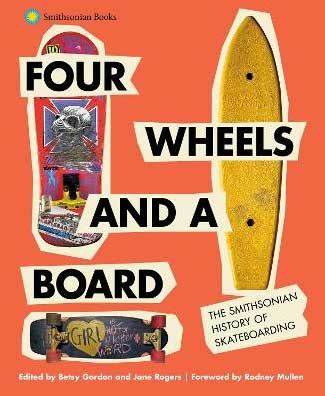
Four Wheels and a Board: The Smithsonian History of Skateboarding,
eds. Betsy Gordon and Jane Rogers (240pp, £33.00, Smithsonian Books)
Back in 1976, when I started skateboarding, I’d never have imagined that the Smithsonian Institution, with their mission of ‘the increase and diffusion of knowledge’, would have a collection of skateboards and associated clothing, photographs, magazines and ephemera, or would issue ‘A History of’ book! Mind you, I would never have foreseen the demise of skateparks, the turn to ramps and street-skating, the return of skateboarding to both sport and fashion circles, or that skateboarding would become an Olympic sport. So what do I know?
Back in late 70s London my friends and I were spoilt for choice… There was a quarter pipe under Westway, a youth club snake run near where the M40 branched to Shepherd’s Bush, the Undercroft at the South Bank, and Meanwhile Gardens. Soon we discovered the very wonderful Rolling Thunder skatepark in a Brentford warehouse, Solid Surf in Harrow, the Mad Dog Bowl in the Old Kent Road, and undertook day trips to Romford, Knebworth and elsewhere.

Rolling Thunder skatepark
Soon, however, bulldozers and property developers moved in. It was a sad day when we took our last skate in the remains of a half-demolished bowl at Rolling Thunder, but Harrow and Meanwhile 2 remained, and we often visited them at night, sometimes skating the former using our motorbike headlights. I kept skating until the late 1980s, mostly using a wide Lonnie Toft deck and Green Bones wheels I had picked up in the States the summer I worked for Camp America. We built a makeshift wooden ramp at the camp, and I visited concrete skateparks in Detroit and New York before I flew home. There were some other skaters back home at college in the 1980s, but when I moved to Devon it all became a bit much: I seemed to be the only 27 year old hanging around on the car park roof with a skateboard, amongst groups of 12 and 14 year kids. I haven’t skated that much since, though I’ve still got my main deck. (Sad to say, my older deck, with original Red Kryps wheels went AWOL a few years ago.)
While I wasn’t looking, those who kept skating commandeered and rode street furniture, shovelled the sand, earth and rubbish out of skateparks that had been filled-in rather than demolished, started skate zines, and assembled massive wooden pipes and bowls instead of concrete ones. These facilitated the development of massive aerials, turns and seemingly impossible new tricks, leading to further media attention, a groundswell of new skaters, skateboarding’s place in the likes of the X-Games and the selections as an Olympic sport. Meanwhile, new skateparks were being designed and built, whether in wood or concrete, with a focus on shape and transitions rather than making a quick buck. The South Bank got saved from redevelopment, and Romford got Grade 2 listing and protected status.

The picture seems to have been pretty much the same the world over. A sport returning to its ‘sidewalk surfing’ roots and gaining massive popularity as a countercultural or ‘punk’ alternative to establishment sports. Find a smooth patch of concrete, or a kerb, a tarmac path or a sloping wall, and you could skate. And just as surf clothing became mainstream fashion, so too did skateboard clothing. Indie board makers, clothing manufacturers and new zines sprung up, community groups, local councils and funding bodies got together to raise money for new facilities.
There have, of course, been skateboarding books before. From rip-off ‘how to’ illustrated manuals to nostalgic overpriced collections of photo from the 80s, via Trawler’s superb documentary publications of 70s UK skateparks, ramps, and drainage pipes and Tony Hawk’s biography, the scene is now well documented both currently and retrospectively. There’s even a new edition of Ian Borden’s Skateboarding and the City, an academic book about architecture and the skateboarding experience, and a 10th anniversary reprint of the wonderful Disposable Skateboard Bible with its endless catalogue of skateboard decks. And of course, social media and Youtube are stuffed with stunts, tricks, injuries and close scrapes; experts and idiots showing us their skills and/or sometimes damaging self-determination.
There hasn’t, however, been a book quite as comprehensive and wide-ranging as Four Wheels and a Board though. It really gets the bit between its teeth and tries to cover everything: history, clothing & fashion, skateparks, gender and sexism, punk, technology, ramps, music, counterculture and skating personalities. Drawing on their now well-established collection of skateboards and accompanying skateboarding artefacts and ephemera, the book is fully illustrated and is a diverse and exciting compilation of history, opinion, and memoir, along with many surprisingly personal sections such as Tony Hawk’s ‘My Last 900’, Brian Anderson’s ‘Coming Out to the Guys in the Van’ and Dan Mancini’s ‘Skating While Blind’.
If at times the book is prone to a sense of self-importance about the Smithsonian skateboarding collection, and to attempting to ‘get down with the kids’ and understand youth culture, its editors and contributors are nevertheless to be applauded for its inclusivity and diversity as well as the comprehensive range of approaches to its subject matter. Whether you are into hardware, graphics, graffiti, clothing, nostalgia, or the social, industrial, countercultural and business elements of skateboarding, or culture in general, there is something for you here.
Rupert Loydell
